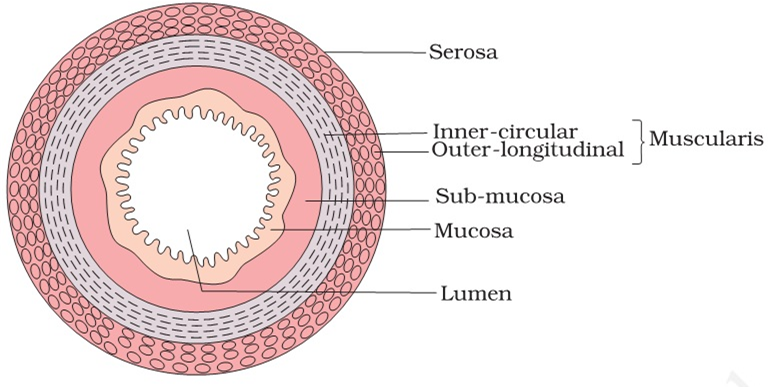 Long Answer Type
Long Answer TypeDiscuss the main steps in the digestion of proteins as the food passes through different parts of the alimentary canal.
 Short Answer Type
Short Answer TypeAnswer briefly
(c) What are the basic layers of the wall of alimentary canal?
The basic layers of the alimentary canal are :
i. Serosa - It is the outermost layer of the human alimentary canal. It is made up of a thin layer of secretory epithelial cells, with some connective tissues underneath.
ii. Muscularis is a thin layer of smooth muscles arranged into an outer longitudinal layer and an inner circular layer.
iii. Submucosa is a layer of loose connective tissues, containing nerves, blood, and lymph vessels. It supports the mucosa
iv. Mucosa is the innermost lining of the lumen of the alimentary canal. It is mainly involved in absorption and secretion
 Long Answer Type
Long Answer Type Short Answer Type
Short Answer Type Multiple Choice Questions
Multiple Choice QuestionsWhich of the following guards the opening of hepatopancreatic duct into the duodenum?
illeocaecal valve
Pyloric sphincter
Sphincter of Oddi
Sphincter of Oddi
In the stomach, gastric acid is secreted by the
parietal cells
peptic cells
acidic cells
acidic cells
Select the correct match of the digested products in humans given in column I with their absorption site and mechanism in column (II).
|
Column I |
Column II |
|
Glycine and glucose |
Small intestine and active absorption |
|
Column I |
Column II |
|
Fructose and Na+ |
Small intestine passive absorption |
|
Column I |
Column II |
|
Glycine and glucose |
Small intestine and active absorption |
|
Column I |
Column II |
|
Glycerol and Fatty acids |
Duodenum and move as chilomicrons |
|
Column I |
Column II |
|
Glycerol and Fatty acids |
Duodenum and move as chilomicrons |
The primary dentition in human differs from permanent dentition in not having one of the following type of teeth
Canine
Premolars
Molars
Molars
The enzyme that is not present in succus entericus is
maltase
nucleases
nucleosidase
nucleosidase
